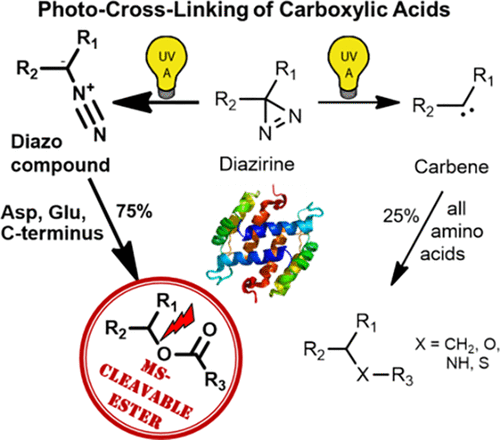当前位置:
X-MOL 学术
›
Anal. Chem.
›
论文详情
Our official English website, www.x-mol.net, welcomes your
feedback! (Note: you will need to create a separate account there.)
Carboxyl-Photo-Reactive MS-Cleavable Cross-Linkers: Unveiling a Hidden Aspect of Diazirine-Based Reagents
Analytical Chemistry ( IF 6.7 ) Pub Date : 2018-02-08 00:00:00 , DOI: 10.1021/acs.analchem.7b04915
Claudio Iacobucci 1 , Michael Götze 1 , Christine Piotrowski 1 , Christian Arlt 1 , Anne Rehkamp 1 , Christian Ihling 1 , Christoph Hage 1 , Andrea Sinz 1
Analytical Chemistry ( IF 6.7 ) Pub Date : 2018-02-08 00:00:00 , DOI: 10.1021/acs.analchem.7b04915
Claudio Iacobucci 1 , Michael Götze 1 , Christine Piotrowski 1 , Christian Arlt 1 , Anne Rehkamp 1 , Christian Ihling 1 , Christoph Hage 1 , Andrea Sinz 1
Affiliation

|
A major challenge in cross-linking/mass spectrometry (MS) is targeting carboxyl functions in proteins under physiological conditions that do not disturb the protein’s conformation. Cross-linking of glutamic acid and aspartic acid residues in proteins will greatly expand the scope of structural mass spectrometry. We discovered that carboxyl-reactive cross-linkers have already been employed for many years in cross-linking/MS studies, yet in a completely different context. Diazirine-based cross-linkers, such as photomethionine and succinimidyldiazirine cross-linkers, are currently considered to react nonspecifically upon UV-A photoactivation with all 20 proteinogenic amino acids through a reactive carbene that inserts mainly into C–H bonds. We discovered that the cross-linking capability of diazirines based on X–H (X = C, N, O) insertion is in fact only the tip of the iceberg. Diazirines isomerize to linear diazo compounds that can react with carboxylic acids to yield esters. On top of that, the resulting cross-linked products are MS-cleavable allowing an automated analysis of cross-links via customized software tools. Therefore, diazirines open an entirely new route for photo-cross-linking of carboxylic acids. Previous cross-linking studies using diazirines have to be revisited in the light of these findings.
中文翻译:

羧基光反应性MS可裂解的交联剂:揭示出基于二嗪基的试剂的隐藏方面
交联/质谱法(MS)的主要挑战是在不干扰蛋白质构象的生理条件下靶向蛋白质中的羧基功能。蛋白质中谷氨酸和天冬氨酸残基的交联将大大扩展结构质谱的范围。我们发现,羧基反应性交联剂已经在交联/ MS研究中使用了很多年,但是在完全不同的情况下。目前认为基于二嗪啉的交联剂,例如光甲硫氨酸和琥珀酰亚胺二氮杂嗪交联剂,通过主要插入C–H键的反应性碳烯,在UV-A光活化后与所有20个蛋白原氨基酸发生非特异性反应。我们发现基于X–H(X = C,N,O)实际上只是冰山一角。重氮嗪异构化为线性重氮化合物,可以与羧酸反应生成酯。最重要的是,生成的交联产品可通过MS裂解,从而可以通过定制的软件工具对交联进行自动分析。因此,重氮嗪为羧酸的光致交联开辟了一条全新的途径。鉴于这些发现,必须重新审查先前使用二嗪类的交联研究。二嗪类为羧酸的光交联开辟了一条全新的途径。鉴于这些发现,必须重新审查先前使用二嗪类的交联研究。二嗪类为羧酸的光交联开辟了一条全新的途径。鉴于这些发现,必须重新审查以前使用二嗪类的交联研究。
更新日期:2018-02-08
中文翻译:

羧基光反应性MS可裂解的交联剂:揭示出基于二嗪基的试剂的隐藏方面
交联/质谱法(MS)的主要挑战是在不干扰蛋白质构象的生理条件下靶向蛋白质中的羧基功能。蛋白质中谷氨酸和天冬氨酸残基的交联将大大扩展结构质谱的范围。我们发现,羧基反应性交联剂已经在交联/ MS研究中使用了很多年,但是在完全不同的情况下。目前认为基于二嗪啉的交联剂,例如光甲硫氨酸和琥珀酰亚胺二氮杂嗪交联剂,通过主要插入C–H键的反应性碳烯,在UV-A光活化后与所有20个蛋白原氨基酸发生非特异性反应。我们发现基于X–H(X = C,N,O)实际上只是冰山一角。重氮嗪异构化为线性重氮化合物,可以与羧酸反应生成酯。最重要的是,生成的交联产品可通过MS裂解,从而可以通过定制的软件工具对交联进行自动分析。因此,重氮嗪为羧酸的光致交联开辟了一条全新的途径。鉴于这些发现,必须重新审查先前使用二嗪类的交联研究。二嗪类为羧酸的光交联开辟了一条全新的途径。鉴于这些发现,必须重新审查先前使用二嗪类的交联研究。二嗪类为羧酸的光交联开辟了一条全新的途径。鉴于这些发现,必须重新审查以前使用二嗪类的交联研究。































 京公网安备 11010802027423号
京公网安备 11010802027423号